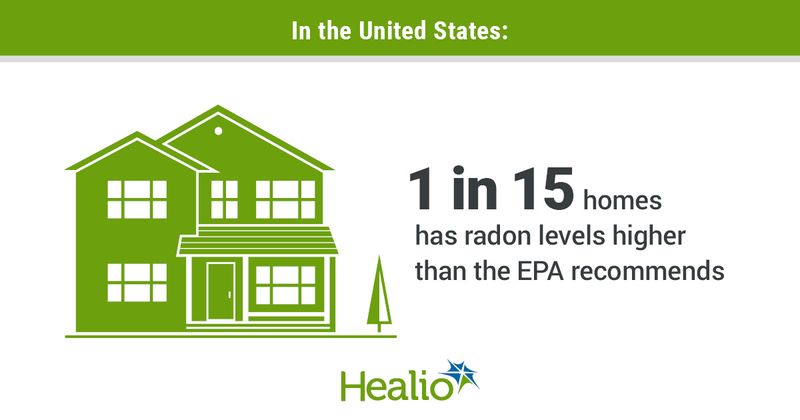Q&A: Few family physicians tell patients about the dangers of radon
Exposure to the colorless, odorless gas called radon is the second leading cause of lung cancer in the U.S. and the leading cause of lung cancer among nonsmokers, according to the American Cancer Society.
The Environmental Protection Agency, HHS and CDC estimate that almost 7% of homes in the U.S. have “elevated” radon levels. Because many people are unaware of its health effects, some experts say that physicians have a responsibility to inform their patients about the dangers of radon exposure.

“Family physicians play a fundamental role in the prevention of radon-related lung cancer by educating their patients, guiding them about specific preventive actions, and advocating on patients’ behalf,” Juan Antonio Garcia-Rodriguez, MD, an assistant professor in the department of family medicine at the University of Calgary in Alberta, wrote in Canadian Family Physician.
However, recent survey results indicate that many family physicians do not talk to their patients about radon. Researchers administered the survey to 350 family physicians in North Dakota in 2020. They evaluated physicians’ radon knowledge through 12 true/false questions and measured physicians’ radon beliefs through 12 questions that were measured on one- to five-point Likert scales.
Among the 204 physicians who completed the survey, the researchers wrote in the Journal of the American Board of Family Medicine that 70% “correctly identified radon as radioactive;” 67% said they do not notify patients about radon; and 80% said they never talked about the combined hazards of radon and smoking with their patients. The survey also showed that 35% of family physicians tested their own homes for radon.
Although the survey took place in North Dakota — where, according to the researchers, some homes contain 10 times the nationwide average for indoor radon levels, which is three times higher than the amount of radon that the EPA deems livable — family physicians across the U.S. should discuss radon with their patients.
“Although screening for hazards like smoking, hypertension and depression are routine elements of primary care practice, radon education is not,” they wrote. “This is a gap that could be filled by family physicians.”
The researchers noted that radon exposure has been linked to about 21,000 lung cancer deaths in the U.S. each year, exceeding the number of deaths due to drunk driving, which is estimated to be 17,400 fatalities annually.
We asked two of the study authors, David Schmitz, MD, a professor of family and community medicine at the University of North Dakota, and Gary G. Schwartz, PhD, MPH, chair of the department of population health at the University of North Dakota School of Medicine & Health Sciences, to provide more information about radon.
Healio Primary Care: Should PCPs discuss radon with their patients? If so, what information should they share?
Schmitz: Yes. For example, given that patients who smoke are much more likely to suffer cancer risk associated with radon, combining tobacco cessation counseling with radon education in high-radon states would be a good start. This could be done by providing simple information on radon awareness, testing and home remediation.
Healio Primary Care: Your survey found that most North Dakota family physicians knew about the health effects of radon, but few shared that information with their patients. Why do you think this is so?
Schmitz: This is an area for further study. Certainly, family physicians provide a very wide-ranging and large amount of health information to their patients. Time and avoiding “information overload” for patients are limiting factors in health care practices and public health education. Providing those patients most at risk with the prioritized information to improve their personal health should be a goal and applying this strategy could increase the frequency of providing radon education.
Healio Primary Care: The survey was limited to North Dakota. What are the implications nationwide?
Schmitz: This study could be replicated in other states and would be most appropriate in other states with naturally occurring high radon levels. In North Dakota, we are researching combining radon education and testing with public health measures, such as tobacco cessation “quit lines.” This could be another area of research and modality for public service with national implications.
Healio Primary Care: What geographic regions are more susceptible to higher levels of radon exposure?
Schwartz: Radon levels in the U.S. tend to be highest in the upper Midwest and in parts of Pennsylvania. They are also high in many areas of Canada. However, the region of the country is no guarantee that a home even in a lower radon zone might not have high radon levels. One in 15 homes has radon levels higher than the EPA recommends.
Healio Primary Care: What are some of the signs and symptoms of radon poisoning?
Schwartz: Radon will not produce symptoms until it has damaged lungs by scarring or lung cancer. Thus, symptoms occur too late for them to be useful in reducing the risk for cancer.
Healio Primary Care: What is your take-home message to physicians?
Schmitz: Providing radon education to the public and to our patients is important and historically has been too often overlooked. Combining radon education with tobacco cessation counseling could be an effective and efficient way to lower cancer risks for our patients and their families.
References:
American Cancer Society. Radon and cancer. https://www.cancer.org/cancer/cancer-causes/radiation-exposure/radon.html. Accessed Aug. 12, 2021.
EPA, HHS, CDC. A citizen’s guide to radon. https://www.epa.gov/sites/default/files/2016-02/documents/2012_a_citizens_guide_to_radon.pdf. Accessed Aug. 11, 2021.
Garcia-Rodriguez JA. Can Fam Physician. 2018 Jul; 64(7): 496–501.
Schmitz D, et al. J Am Board Fam Med. 2021;doi: 10.3122/jabfm.2021.03.200553.
